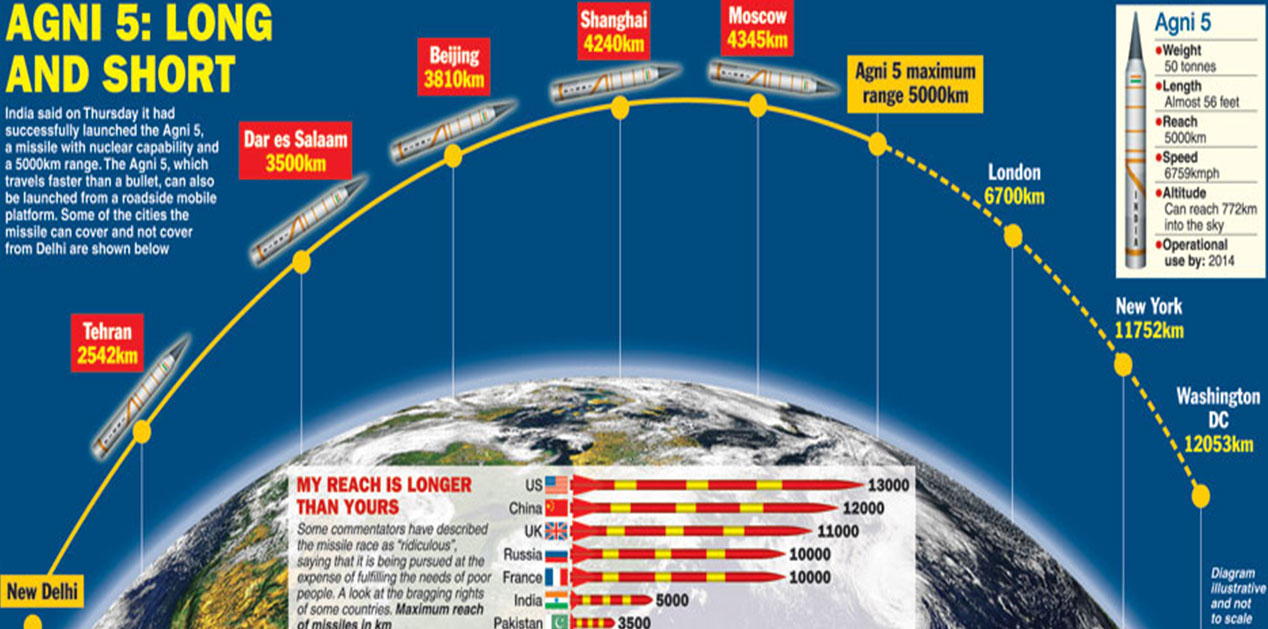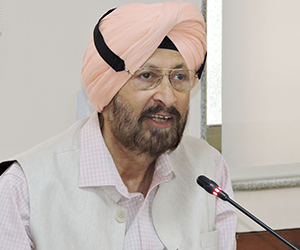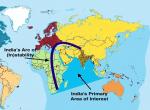On December 26, 2016, India tested the 5,000 plus km Agni-5 IRBM for the fourth time. The test that was conducted from Kalam Island in the Bay of Bengal achieved all the mission parameters that had been stipulated. After user trials over the next 18 to 24 months, the nuclear capable Agni-5 missile will be inducted into the Strategic Forces Command (SFC). On its operationalisation, all targets in China will come within range from India.
India’s nuclear force structure is based on a triad: Prithvi short-range ballistic missiles and various versions of the Agni intermediate-range ballistic missile manned by the missile groups of the Indian Army; nuclear glide bombs carried on aircraft of the Indian Air Force (IAF); and, eventually, submarine-launched ballistic missiles (SLBMs) deployed on ballistic missile submarines (SSBNs) with the Indian Navy. INS Arihant, the first indigenously designed SSBN, is undergoing sea trials as of 2016 and a second SSBN is reported to be under construction. However, nuclear-armed ballistic missiles are the sheet anchors of India’s nuclear deterrence at present and will remain so till all the SSBNs enter service with the SFC.
Surface-to-Surface Ballistic Missile Groups
Under the aegis of its Integrated Guided Missile Development Program (IGMDP), which was approved by the government on July 26, 1983, India has achieved considerable success in ballistic missile development. The Prithvi SRBM (1-meter diameter, 150- to 350-km range, and liquid-fuelled) and the multiple models of Agni IRBM (800- to 5,000-km range, and solid-fuelled) have provided India with an assured retaliation capability. Though exact details are not known in the public domain, DRDO spokespersons have shared sufficient information to allow for an assessment of the missile’s capabilities. While the Agni-V is still under development, the Agni-IV is reported to be ready for deployment. According to a Ministry of Defence press release, “Agni 3 got [sic] inducted to strengthen India’s strategic might and joined Agni 1, Agni 2, Prithvi II & Dhanush (the naval version of Prithvi capable of being launched from ships even under rough sea conditions).”
Agni IRBMs are the mainstay of the surface-to-surface leg of India’s strategic forces. With the exception of the Agni-I, all Agni missiles are fully solid-fuelled with carbon composite heat shields for re-entry protection. At least two Agni missile groups are reported to be in service. The Agni-V, with a claimed range of 5,000 km plus, is known to be capable of carrying MIRV warheads. A canisterised version of the Agni-V was first test-fired on January 15, 2015, from a mobile launcher. The process of canisterisation means the warhead will be mated with the missile for storage, not stored separately and mounted on the missile shortly before launch. V. K. Saraswat, a former DRDO chief, said the Agni-V had “ushered in fantastic opportunities in . . . building Anti-Satellite (ASAT) weapons and launching mini/micro satellites on demand”. The DRDO also plans to develop the Agni-VI IRBM, which will be capable of carrying a 3-ton payload of manoeuvrable MIRVs. The range of the missile is expected to be greater than 6,000 km. Table 2 provides a reasonably accurate assessment of the basic characteristics and status of the Agni missile.
Agni Series of Ballistic Missiles
| Designations | Type | Range (km) | Warhead (kg) | Status |
|---|---|---|---|---|
| Agni I | Two stage, solid/liquid fuel SRBM | 1,250 | 1,000 | In service. Last tested 8 November 2013. |
| Agni II | Two stage, solid fuel IRBM | 2,500 - 3,000 | 1,000 | In service. Last tested 7 April 2013. |
| Agni III | Two stage, solid fuel IRBM | 3,000-3,500 | 2,000 | In service. Last tested 23 December 2013. |
| Agni IV | Two stage, solid fuel IRBM | 4,000 | 1,000 | In development; last tested 20 January 2014. |
| Agni V | Three stage, solid fuel IRBM; described as ICBM | 5,000 | Unknown | In development; last tested 15 September 2013. |
Source: Brian Cloughley, “India Increases its Uranium Enrichment Programme,” Jane’s Intelligence Review, June 20, 2014, test dates as given by the author cited
http://www.janes.com/article/38957/india-increases-its-uranium-enrichment-programme
The Prithvi-I (150-km range), Prithvi-II (250-km range, IAF version), and Prithvi-III (350-km range) surface-to-surface missiles (SSMs) are all nuclear-capable. Prithvi missiles are liquid-fuelled with strap-down inertial guidance and a manoeuvrable trajectory with a CEP likely less than 100 meters. These dual-use missiles are capable of carrying 500- to 1,000-kilogram warheads. Four Prithvi missile groups (222, 333, 444, and 555) are reported to be in service. As soon as the Agni-I regiments are fully operational and the missiles have been produced in the required numbers, it should be possible to retire the Prithvi missiles from service with India’s nuclear forces. However, Prithvi missiles are likely to continue to be used for non-nuclear missions and as part of the ballistic missile defence (BMD) technology development program until they become obsolete. A modified Prithvi missile is, for example, the interceptor in the BMD system Prithvi Air Defence (PAD) for exo-atmospheric interception. It is also used as a target for an incoming missile.
The Dhanush SSM is a ship-to-surface variant of the Prithvi-III with a maximum range of 350 km. The Nirbhay – also tested in December 2016, but unsuccessfully – is a subsonic (Mach 0.7) land attack cruise missile (LACM) with a maximum range of 1,000 km. The Prahar is a highly manoeuvrable, precision-strike tactical SSM with a range of 150 km, and is armed with a conventional warhead. Comparable to the US Army Tactical Missile System, it has been conceived as a quick-reaction battlefield support weapon system that fills the range gap between tactical multi-barrel rocket launchers and SRBMs. All of these missiles have been indigenously developed by the Aeronautical Development Establishment and have been produced by Bharat Dynamics Limited.
Securing Missile Launchers
A substantial proportion of the land-based ballistic missile force is likely to be destroyed in a disarming first strike, or even in a conventional strike in the course of a war below nuclear thresholds. Missiles of the lower-range Agni class can be made road- and rail-mobile and can be moved around large areas in a random, unpredictable manner. Though mobile missiles are less vulnerable because they are harder to locate and track, surveillance and target acquisition technologies are improving rapidly and adversaries planning first-strike strategies may be expected to make the required investments in the ISR technology necessary to find mobile missiles.
Missiles can also be housed in hardened, above-ground shelters and moved frequently from one shelter to the other, or emplaced in underground silos that are designed to withstand the overpressures likely to be generated by nuclear explosions of 20 to 30 kilotons. Hardened shelters can be easily spotted by modern satellites and would be destroyed in a disarming first strike. To ensure the survival of a retaliatory capability in hardened shelters, India would have to construct two or three structures for each missile, including some realistic dummy shelters equipped with dummy missiles mounted on actual transporter erector launchers that are frequently moved to simulate the presence of a real missile.
Fixed silos capable of withstanding a nuclear attack are extremely costly to construct and maintain. So far, it has not been possible even for advanced Western countries to construct shelters capable of withstanding megaton nuclear blasts. Such silos are technologically challenging and prohibitively costly. Should India’s adversaries choose to employ such high-yield weapons in the future, fixed silos would be virtually useless. Even with silos, it is still likely that a first strike would destroy 40 to 50 percent of India’s land-based arsenal. It is for these reasons that there is no move in India to build silos for India’s strategic missiles.
SLBMs and Cruise Missiles
The first SLBM developed for India’s SSBN fleet is the 700-km-range Sagarika. After gaining technical knowledge of the process of soft ejection underwater followed by ignition of the missile motor with the Sagarika, DRDO scientists began developing the K-4 SLBM, which is expected to have a maximum range of 2,000–3,500 km. The K-4 is undergoing technical trials as of 2016. At its maximum range, the K-4 could reach some high-value targets in Pakistan from a standoff distance in the Bay of Bengal. It would, however, still fall short of high-value targets on the Chinese mainland. In order for India to threaten high-value targets in China with the K-4, SSBNs would have to patrol very close to the Chinese coastline. With these targets in mind, India will inevitably have to develop an SLBM with a range of 5,000 km.
The BrahMos supersonic cruise missile was developed jointly with Russia. It is designed to be launched from land-based mobile launchers, surface ships, submarines, and fighter-bomber aircraft. It has a maximum range of 290 km and carries up to a 300-kilogram conventional warhead. The maximum speed of the missile is Mach 2.8, almost three times faster than the US Tomahawk subsonic cruise missile. INS Rajput was the first Indian ship to be equipped with BrahMos missiles in 2005. The first army regiment was equipped with BrahMos missiles in 2007, and the second five years later in 2012. Hindustan Aeronautics Limited handed over the first Su-30MKI modified for the BrahMos missile to BrahMos Aerospace in February 2015. The BrahMos-II, a hypersonic version of the missile with a scramjet engine, is under development. According to news reports, the range of the BrahMos missile may be increased to about 600 km, giving it greater stand-off. There are currently no plans to arm the BrahMos with nuclear warheads; reports to this effect are misleading. India will never violate the provisions of the Missile Technology Control Regime (MTCR) by arming the BrahMos with a nuclear warhead. Both India and Russia are members of the MTCR.
Looking Ahead
India must continue to endeavour to modernise its nuclear delivery systems. In particular, India must close the missile-technology gap with both China and Pakistan as early as possible, or else the credibility of India’s nuclear deterrence will remain suspect. India must step up efforts to acquire missiles with ranges between 5,000 and 10,000 km for better long-range deterrence against China. The Agni-VI/Surya programme, which can benefit from the Indian Space Research Organization’s Polar Stationary Launch Vehicle and Geosynchronous Satellite Launch Vehicle, needs to be given high research and development priority.
For a nation that follows a no-first-use nuclear doctrine and is willing to absorb a nuclear first strike, genuine deterrence can be provided only by a robust, infallible, and potentially insuperable nuclear force including ballistic missiles and SSBNs armed with nuclear-tipped SLBMs. It is imperative for India to make all efforts to operationalise its SSBNs as early as possible. Until SSBNs enter service with the Indian Navy, a small number of surface combatants in both the eastern and western naval fleets should be equipped with nuclear-tipped ballistic missiles to add variety to the direction of launch that an adversary must counter.
(The writer is Visiting Fellow, VIF, and Distinguished Fellow, Institute for Defence Studies and Analyses (IDSA), New Delhi).
Published Date: 2nd January 2017, Image Source: https://encrypted-tbn1.gstatic.com











Post new comment